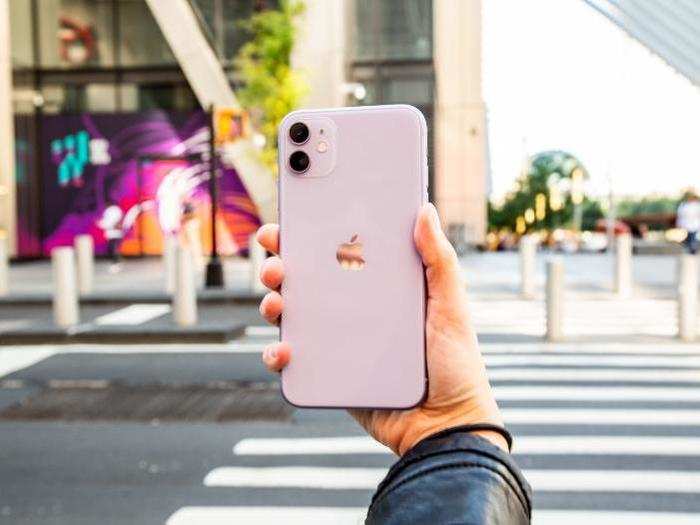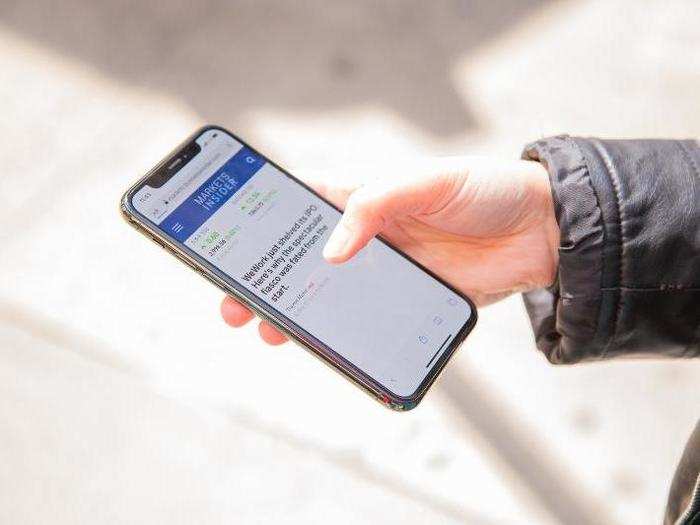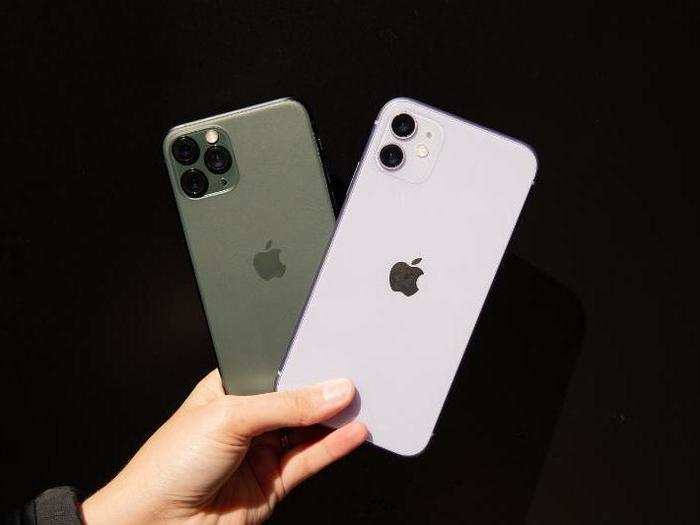- Home
- slideshows
- miscellaneous
- After spending two full days with Apple's new iPhones, I'm convinced the iPhone 11 is the best choice for most people - here's why
After spending two full days with Apple's new iPhones, I'm convinced the iPhone 11 is the best choice for most people - here's why
Camera

iPhone 11 (Bright outdoor shot)

Google Pixel 3a XL (Bright outdoor shot)
Samsung Galaxy S10 (Bright outdoor shot)

iPhone 11 Pro (Low light)

Google Pixel 3a (Low light)
Samsung Galaxy S10 (Low light)

Battery life

With the iPhone 11, you can rest assured that you won't be left stranded in search of a power outlet. I used the iPhone 11 Pro for roughly a day and a half — about 32 hours — without charging it and still had about 15% of its battery left.
I'd usually consider that to be normal; after all, most of the phones I test can last for about a day and a half on a single charge. But I accidentally left the phone's screen at maximum brightness for about two hours after a video shoot — while also setting the display to never time out — and was still able to get regular battery life. (This was while using the regular Pro, you can probably expect to get slightly longer battery life out of the larger Pro Max).
The iPhone 11 seems to be performing well when it comes to battery life, too. At the time of writing, I've been using the phone from about 6:30 a.m. to 5:45 p.m., and I still have 71% of juice left.
Battery life will always vary depending on how you use your phone. During this testing period, I used these phones for checking email, browsing social media, taking photos, streaming music (roughly one to two hours) and video (roughly 20 minutes), and checking my job's Slack channel. If you use your phone for similar tasks, you can probably expect battery results like this.
The new iPhones also finally come with an 18-watt charger for juicing up your device more quickly — a much-requested upgrade from the smaller charging brick that older iPhones came with.
Design

There's another physical characteristic that makes the new iPhones stand out from their predecessors: their colors and design. The iPhone 11 Pro and Pro Max have a new textured matte back, which gives the phones a more premium feel. It also makes them less prone to fingerprint smudges if you're brave enough to use them without a case compared to rivals like the Galaxy S10.
The iPhone 11 has the more familiar glossy glass back that makes it resemble the iPhone XR, but comes in new colors that have a pastel-like aesthetic.
One trait that hasn't changed much, however, is the notch cutout that sits near the top of the display. It's just as noticeable as it was last year and the year before on the iPhone X, which is somewhat disappointing considering other smartphone makers like Samsung have done more to make that cutout blend more seamlessly into the phone's display.
Samsung, for example, has squeezed the front-facing camera and facial recognition sensors into a tiny circular space carved out near the top of the screen on its Galaxy S10 and Galaxy Note 10 phones. That makes the design seem all the more striking since it creates a more convincing illusion that the screen stretches from edge-to-edge.
But that may have its consequences, however, as the Galaxy S10's facial recognition is said to be less secure than Apple's, and security should definitely be prioritized over aesthetics.
The new iPhones also lack an in-screen fingerprint sensor unlike rivals such as Samsung, which means you have fewer choices when choosing how to unlock your phone compared to alternatives.
The iPhone 11 Pro has gotten some enhancements when it comes to durability, too. The Pro models can withstand being submerged in up to four meters of water for as long as 30 minutes. Last year's iPhones, and the iPhone 11, can only handle being dunked in two meters of water for the same period of time.
Display and audio

The iPhone 11 and 11 Pro have also gotten some minor upgrades when it comes to the display and audio quality. The Pro's screen is now brighter than that of last year's iPhone (and the 11), but you'll likely only notice this when using the phone outdoors in very sunny conditions.
The cheaper iPhone 11 also has an LCD screen versus the 11 Pro's OLED screen, similar to the difference between last year's iPhone XR and iPhone XS. This isn't too noticeable in everyday use, but the difference does become obvious whenever the screen turns mostly black — whether it be a dark transition between scenes in a movie trailer or a wallpaper with a mostly black backdrop. That's because LCD screens can't reach the same level of blackness as OLED displays.
All of the new iPhones also have spatial audio playback, which provides a mildly noticeable boost in sound quality. This was most evident when watching movie trailers on the 11 versus the iPhone XS Max, since it made the cinema score sound richer and more full-bodied. But since I use headphones more often when listening to music or watching video on my phone, I didn't find myself making use of the spatial audio very much.
Should you get it?

If you're trying to decide whether to upgrade to the newest iPhones, I'd urge you to think about what features matter most to you and how much you're willing to spend.
The upgrade is certainly worth it if you're operating on an older model like the iPhone 7 or earlier, but if you have an iPhone X or iPhone XS you'll probably want to hold off for at least another year or so. Unless you're really itching to try use that ultra-wide-angle camera or take better photos in the dark, the improvements in this year's model likely aren't crucial enough to justify an upgrade.
Perhaps you already know you want the latest iPhones, but you're not sure whether to go with the iPhone 11 or 11 Pro. That decision boils down to how much having an extra camera lens really matters to you.
The iPhone 11 Pro has a telephoto lens for better zooming in addition to its wide-angle and ultra-wide-angle lens, both of the latter are also found on the iPhone 11 Pro. That extra lens also gives you more flexibility when it comes to taking Portrait Mode shots, since you can opt for a bokeh-style shot with a tighter zoom through the telephoto lens or one that takes in more of the scene with the wide-angle lens.
The iPhone 11 Pro's screen is also brighter than the 11's and offers better contrast and deeper blacks, but you probably wouldn't notice that enough to let it significantly impact your buying decision.
The iPhone 11, given the fact that it shares many of the features of the Pro at a much lower price, is probably the right choice for most people. But camera professionals that need the flexibility of shooting with three different lenses instead of two might be more interested in the Pro.
Taken together, the updates in the iPhone 11 and iPhone 11 Pro also say a lot about the state of the smartphone industry. That Apple is positioning its lower-cost iPhone 11 as its flagship model this year shows that it learned an important lesson from last year's iPhone XS and XR launch — many people don't want to pay $1,000 or more for a new smartphone.
The fact that Apple is catering toward professional photographers and videographers with its new iPhones is also notable. It suggests that in an era in which people are holding onto their smartphones longer than before, the company is looking to niche audiences — not just general buyers — to encourage upgrades.
Popular Right Now
Popular Keywords
Advertisement